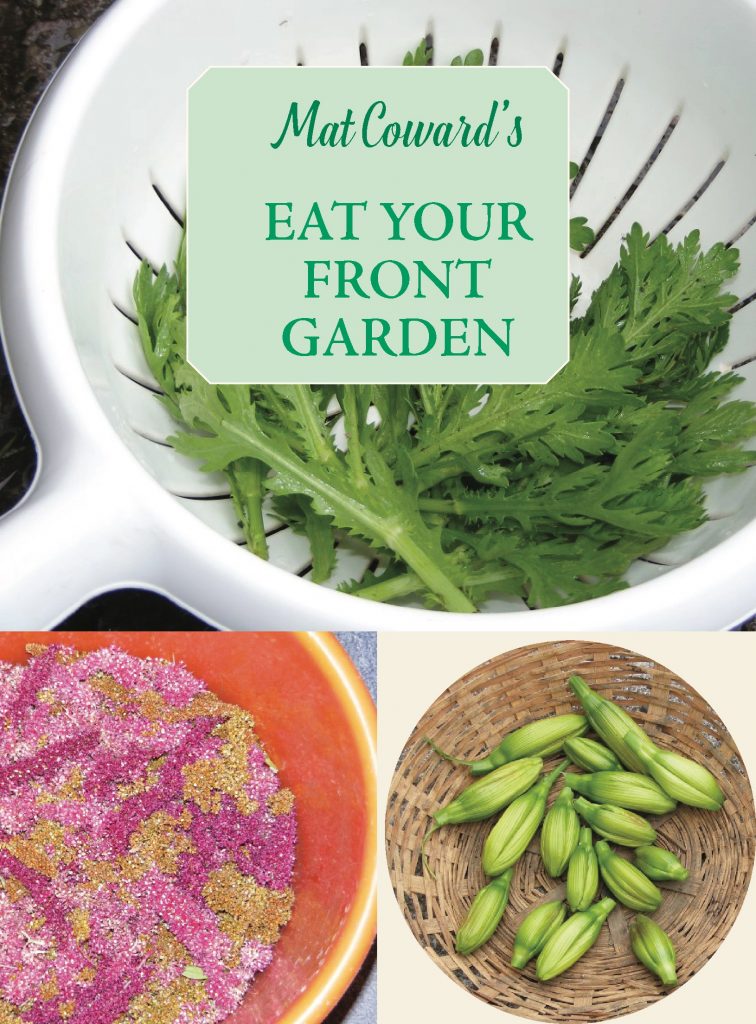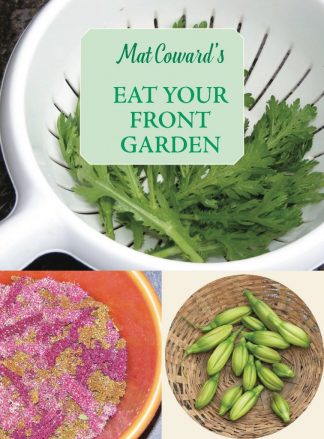Description
Mat Coward
Eat Your Front Garden
Mat Coward’s book could be called the “invisible allotment”. It offers suggestions for edible plants which are easily grown in ornamental gardens. The book gives detailed advice on how to grow and eat the produce from these plants, many of which you may already be growing. Your front garden won’t look like an allotment, but you’ll still harvest a significant amount of food.
There are plants here which are bona fide ornamentals which, to many people’s surprise, have edible parts. Then there are species which are grown as ornamentals in this country, but which are considered vegetables elsewhere. Hosta is a good example; in Japan it’s grown as an agricultural crop. Finally there are lesser-known edible plants, like the Cinnamon Vine (Dioscorea batatas) which is a charmingly-perfumed climber – as long as you don’t tell anyone it has another name – Chinese Yam – and you’re going to dig up the roots, eat them raw or roast them.
Mat Coward is a writer, journalist, and scriptwriter. He writes a gardening column for the Morning Star, and is a scriptwriter on the cult TV show, QI for the BBC. His short stories have been nominated for the Edgar and shortlisted for the Dagger, published on four continents, translated into several languages, and broadcast on BBC Radio..
Reviews:
I first came across Mat Coward’s garden writing when looking up potato onions or some such unusual edible. I discovered that he has been growing and writing about unusual edible plants, such as burdock, Chinese artichokes, mashua, tiger nuts, Mexican sour gherkins, walking stick cabbage and dandelion, for years before the recent popularity of such crops. He is a good person to be writing a book about eating your front garden.
Backyardlarder.co.uk April 2020 Alison Tisdale
‘If there’s any justice in the world, then this marvellous new work by the Morning Star’s gardening columnist Mat Coward should walk away with any gardening book of the year award.
Eat Your Front Garden: The Invisible Allotment is a revelation in showing that your front garden can be as edible as it is ornamental.
In an encyclopaedic volume, embellished by excellent photographs, Coward waxes eloquent on how flowers, shrubs and exotic plants can all be a source of easily grown food, providing a tasty addition to standard cuisine.
Divided into sections dealing with plants grown for their blooms, foliage, climbers, ground cover or hedging, Coward provides a beautifully written and user-friendly guide to their ornamental value, propagation and growing, harvesting, storage and kitchen use.
Throughout there are revelations, in a survey that roams the world. Who knew that sunflowers, usually associated with seeds or oil, can be grown for their edible flowering buds (I certainly didn’t) or that the young shoots of hostas — crack cocaine to slugs — are a staple of Japanese cooking and a savoury addition to salads, soups, risottos or scrambled eggs?
And I mentally kicked myself when I read that the highly decorative water celery, which I used to pull out in clumps and compost when it threatened to annex our garden pond, is good for eating, with a flavour reminding some of parsley or celery.
Coward recommends it in a peanut-butter sandwich: “It’s the kind of food they’d serve at state banquet if they only knew of it,” he sardonically remarks, in an aside typical of many witty comments sprinkled throughout. “I have a dislike of salmon-pink flowers,” he reveals early on. “I don’t know why, perhaps I was bitten by a fish as a child.”
Apart from its great value as a source of reference, two things struck me while reading this book. In the suburban north London street where we live, many of the front gardens have been paved over for parking, meaning that when there’s a downpour, rain sheets off into the roadside.
Apart from wasting water, it exacerbates the problems of the capital’s increasingly overburdened sewage system, and it makes sound environmental sense for front gardens to return to their original purpose and, in the process, act as a sump for excess H2O.
And in this fraught pandemic era, with food security a growing issue, then books like Coward’s are essential as a guide to how we can grow more food ourselves. You don’t even need a garden to do so, because a fair number of the plants in the book can be cultivated in pots or grow-bags.
Even if you’re not a gardener, this book is one to treasure as a mine of erudition and revelation — you’ll never look at a nasturtium in quite the same way again. Cliff Cocker, Morning Star May 2020
‘A clarion call to use all available space to grow food. Excellent suggestions on plants to choose, and brimming with practical details which will give a novice gardener confidence.’ Phil Iddison, engineer and allotment holder


